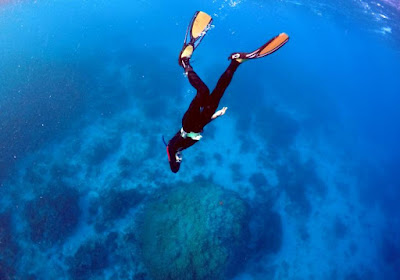The Great Barrier Reef, the world's largest reef system stretching along the East coast of Australia from the northern tip down to the town of Bundaberg., composed of roughly 2,900 individual reefs and 940 islands and cays that stretch for 2,300 kilometres (1,616 mi) and cover an area of approximately 344,400 square kilometres (133,000 sq mi). The reef is located in the Coral Sea, off the coast of Queensland in northeast Australia. A large part of the reef is protected by the Great Barrier Reef Marine Park.
According to the 2014 report of the Australian Government's Great Barrier Reef Marine Park Authority (GBRMPA), climate change is the most significant environmental threat to the Great Barrier Reef, while the other major environmental pressures are listed as decreased water quality from land-based runoff, impacts from coastal development and some persistent impacts from fishing activities. The reef is also threatened by storms, coral bleaching and ocean acidification. The 2014 report also shows that, while numerous marine life species have recovered after previous declines, the strength of the dugong population is continuing to decline. Terry Hughes, Federation Fellow, ARC Centre of Excellence for Coral Reef Studies at James Cook University, wrote in a 14 August 2014 Conversation piece that harmful government policies and ongoing conflicts of interest over mining royalties are risks of an equivalent magnitude.
The GBRMPA consider climate change, poor water quality, coastal development, and some impacts from fishing to be the area's major threats, but reef scientists Jon Day, Bob Pressey, Jon Brodie and Hughes stated that the "cumulative effects of many combined impacts" is the real issue. In a Conversation Article, Mathieu Mongin, a biogeochemical modeller at CSIRO and colleagues mapped parts of the Great Barrier Reef that are most exposed to ocean acidification. This map of pH on the Great Barrier Reef presents the exposure to ocean acidification on each of the 3,581 reefs, providing managers with the information they need to tailor management to individual reefs. The Great Barrier Reef is not a singular reef nor a physical barrier that prevents exchange between reefs; it is a mixture of thousands of productive reefs and shallow areas lying on a continental shelf with complex oceanic circulation.
The Australian and Queensland Governments committed to act in partnership in 2007 to protect the reef, and water quality monitoring programmes were implemented. However, the World Wildlife Fund criticised the slow progress of the governments, raising a concern that as many as 700 reefs continued to be at risk from sediment runoff. The Australian government then outlined further action after the WHC called for the completion of a strategic assessment of the Reef area in 2011. The Committee also urged the government to use the assessment data to develop a long-term plan for protecting the "Outstanding Universal Value" of the reef, which is the basis for its World Heritage listing. Again, criticisms emerged from the expert community—due to vague quantitative targets, the absence of clear, specific strategies, and no mention of the implications of climate change—but the significant efforts of both state and federal governments addressed key recommendations from the World Heritage Committee.
A 2012 UNESCO report, published by the World Heritage Committee (WHC), then criticised the government's management of the Great Barrier Reef, warning that the area could be downgraded to a world heritage site "in danger" unless major changes were implemented. The report expressed "extreme concern" at the rapid rate of coastal development, highlighting the construction of liquefied natural gas plants at Gladstone and Curtis Island, and recommended that thorough assessments are made before any new developments that could affect the reef are approved. UNESCO specifically recommended no new port development in Abbot Point, Gladstone, Hay Point, Mackay, and Townsville.
On the second day of the 2013 round of the biennial training exercise 'Talisman Saber', in which 28,000 US and Australian military personnel conduct joint activities over a three-week period,four unarmed bombs were dropped into the Great Barrier Reef by two US AV-8B Harrier jets that were unable to land with the weight of the weapons. To minimize potential harm to the reef, the four bombs, weighing a total 1.8 metric tons (4,000 pounds), were dropped into more than 50 meters (164 ft) of water away from the reef's coral structures. The bomb drop was originally planned to occur at the Townshend Island bombing range, but after controllers reported that the area was not clear of hazards, the emergency jettison occurred. Australian senator Larissa Waters responded to the news by asking, "Have we gone completely mad? Is this how we look after our World Heritage area now? Letting a foreign power drop bombs on it?"

















0 Comments